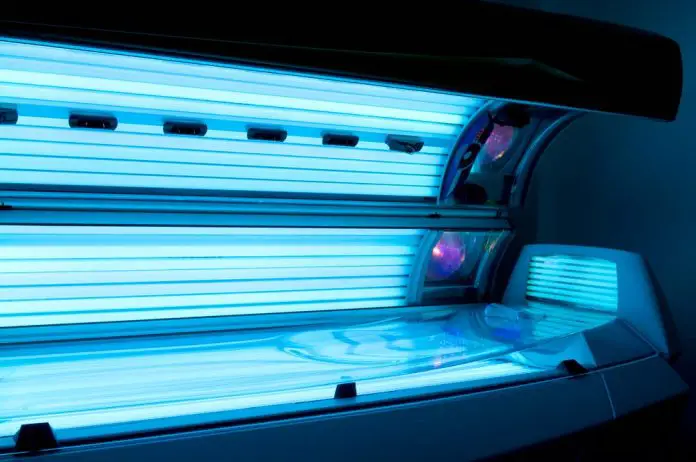If you love to tan, you’ve probably spent time in a tanning bed or booth before. This is an easy, efficient way of getting that coveted sun-kissed glow and, done safely, can help you feel and look summer-ready.
But, just as sitting out in the sun harms your skin, so do tanning beds. The mechanism is the same – you’re getting a dose of UV light that darkens your skin but also damages it.
So you may be wondering if (and how!) you can protect your skin. Everyone knows to wear sunscreen outdoors on a sunny day. When the UV Index goes up, we slather on the lotion.
But does this offer the same protection in a tanning bed? Can you (should you?!) use sunscreen in a tanning bed? We answer that question below, as well as share some tips on skin safety.
Careful, responsible tanning is the key to getting a beautiful golden tone without putting yourself at risk.
What happens when we tan?
Lie out in the sun or under a tanning bed long enough, and you’ll start to go from beautifully bronzed to painful pink.
Ignore the warning signs, and you might even end up suffering for days with burns and/or blistering, flaky skin.
Why? Because UV light damages exposed skin. The sun emits two main types of UV radiation:
- UVA – This is the most prevalent, with almost 500 times more UVA in sunlight than UVB. UVA penetrates the skin more deeply, causing all those unwelcome signs of skin aging, such as wrinkles, lines, and age spots.
- UVB – These rays travel on a smaller wavelength than UVA and are largely responsible for causing sunburn and skin cancer.
A tan is actually a sign that UV radiation has begun to damage our skin. When our skin is exposed to this form of light, it begins to produce melanin.
Melanin is your skin’s defense mechanism, pumped out into the cells to prevent radiation from damaging its mitochondria (i.e., the cell’s ‘control center’). But melanin is also a pigmentation, giving the surface of your skin that darkening color.
Considering the strength of the sun’s rays, sometimes melanin needs a helping hand. This natural pigmentation only offers around 2-4 SPF, so if you’re sitting out for a while, you need the added protection of sunscreen to prevent burning.
Sunscreen works by blocking UV radiation. The higher the SPF, the more protection. No lotion provides 100% coverage, of course, but it does prolong the process so you can stay out longer and get more color without going beet red.
Does sunscreen work in a tanning bed?
If sunscreen can help you get a better tan without burning, then it stands to reason that you could use it in a tanning bed for the same effect. Right?
Yes, and no.
Tanning beds and booths mimic the sun’s UV using artificial light. They mostly emit UVA, as these are the rays largely responsible for tanning.
Because you’re getting a more concentrated dose of UVA, you don’t need to lie in a tanning bed for hours on end, as you would on a sun lounger or at the beach.
So yes, you could use sunscreen, but it’s going to work the same way it does outdoors – blocking UVA and slowing down your tan.
When you’re only in a tanning bed for short periods, it doesn’t make sense to use sunscreen. Presumably, you’re there to tan, and you won’t get your glow by coating your skin in a cream.
If you’re worried about your skin, the best option is to skip the tanning beds entirely and go for a self-tanning lotion or gentle sun exposure outside while wearing a high SPF cream.
Unfortunately, it’s a trade-off. Tanning means skin damage, and the more you tan, the more damage you do.
All that said, if you are determined to darken, there are a few ways you can minimize this damage and still get some color. But, as always, none of these suggestions are foolproof. The bottom line is that tanning undeniably raises your risk of skin cancer.
Skin safety tips
Nourishing your skin while tanning requires a careful cosmetic regime. Show your skin some love before and after you tan to keep it healthy.
Moisturize beforehand, keep sessions short and infrequent, and use a good quality after-sun to ensure your skin stays hydrated post-tanning.
And don’t forget to pay attention! Be alert to any signs of sensitivity and cut your tanning time short if your skin starts complaining.
If you overdo it, the following products are great for skin (and you’ve probably got them in the house already!)
- Coconut oil – a natural antibacterial and antiviral agent, coconut oil is great for keeping skin clean and healthy. It’s also extremely moisturizing too, thanks to its high-fat content.
- Aloe vera – this wonder plant is extremely cooling on burns, rashes, or redness. It’s a natural after-sun that delivers results without harsh chemicals or preservatives.
- Epsom salts – suffering from some angry skin post-tan? Throw some Epsom salts into your bath water! These are a natural anti-inflammatory and work well for any kind of skin irritation. Just remember to keep that bathwater lukewarm so you don’t dry out your skin.
In summary
Can you wear sunscreen in a tanning bed?
Yes.
Should you?
Not if you want to tan!
If you’ve paid for a session in a tanning bed, you want to walk out with a beautiful beachy glow. Using sunscreen may help protect your skin, but it won’t give you your money’s worth when it comes to results.
So you have to decide how badly you want that tan and whether it’s worth the risk.
Sorry to be the bearer of bad news… but to truly protect your skin from UV radiation, skip the sun entirely and ditch indoor tanning. Get your tan from a bottle, or book a spray tan. These are the safest ways to go golden!

